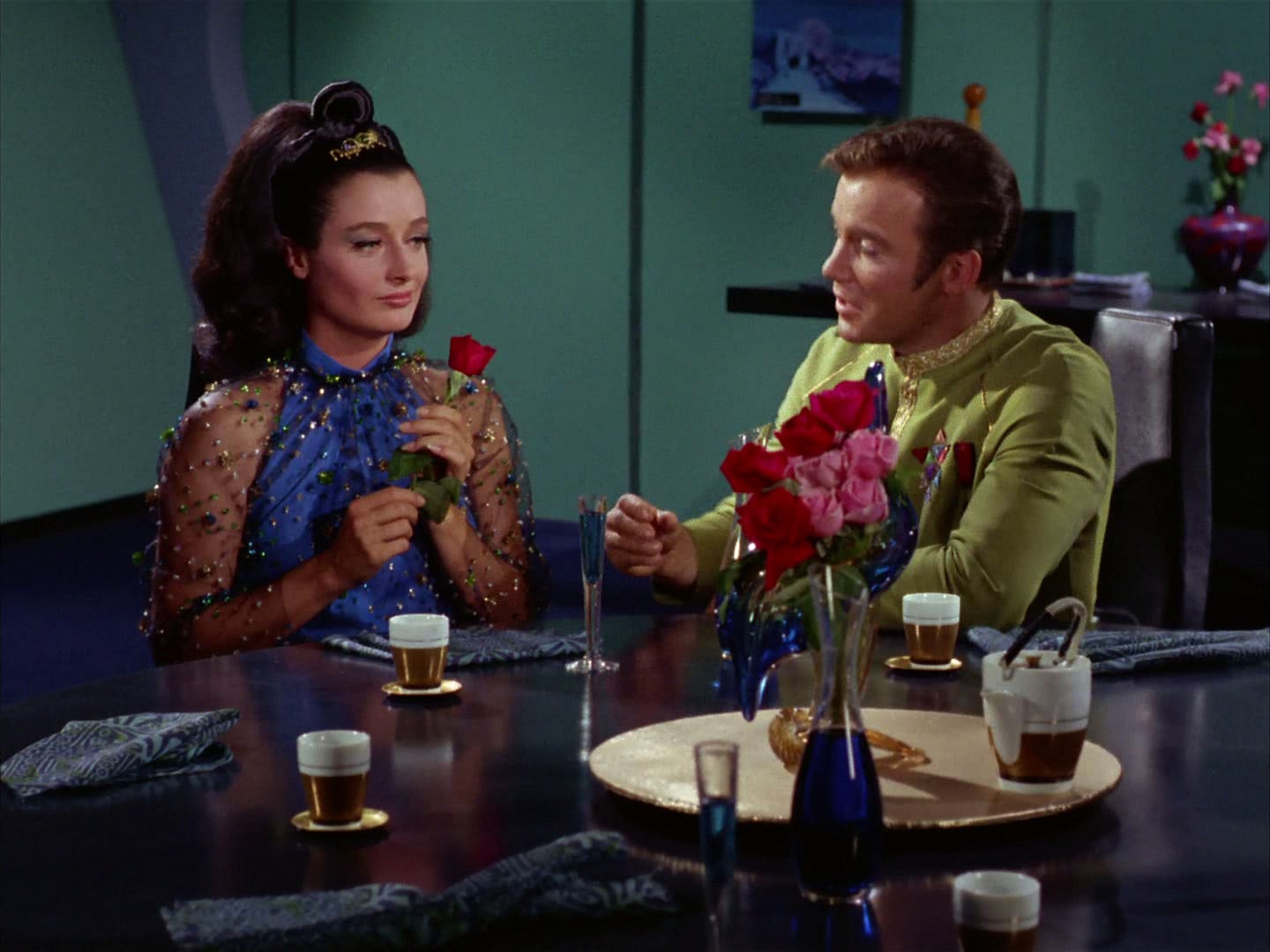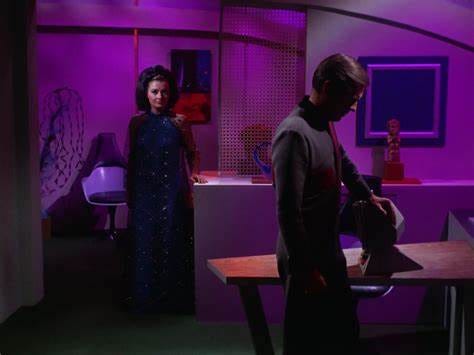"Is There No Truth in Beauty?" - Season 3, Episode 5
Trek asks: can you be so ugly you kill on sight?
“Lovecraftian,” the adjective, is of questionable use. Much like “Lynchian,” or “Kafkaesque,” too often these descriptors of a specific artists sensibility boil down to “weird.” These are artists with strange, particular, inclinations that lie outside of mainstream narrative style. Thus, their oddity ends up taken as their only contribution. Rather than useful descriptors of mood and feeling, these words become mere synonyms for the most obvious aspect of their work: it is specific. But we feel comfortable using “Lovecraftian” here, at least in the episode’s central conceit. The Enterprise must ferry a being so grotesque and impossible to behold that the mere sight of it is enough to drive a man mad. Thankfully, he’s a nice guy!
Kollos, as this being is named, is the “Medusan” ambassador. Perhaps Greek myth is a better reference than Lovecraft, but there are no labyrinths, heroes, or gods in this episode. “Is There No Truth in Beauty” is instead split across myriad interests and influences. Jean Lisette Aroeste’s script is admirable but unfocused, juggling big romantic themes of jealousy, rivalry, and the titular beauty and ultimately letting most of those balls drop. But, like any juggling routine, it is fun enough while it lasts.
The Enterprise is assigned to ferry Kollos and his human companion, Dr. Miranda Jones, to a Medusan ship. Once there, Dr. Jones, a strong telepath, plans to attempt a “mind-meld” with Kollos. The Medusans’ appearance and corporeality keeps them at a distance from the rest of the Federation - Kollos himself is transported in a large metal cylinder and is only portrayed as impressionistic, colorful lights - and any further integration into the galactic community depends on the enhanced communication Dr. Jones promises. At the beginning of the episode, Kollos is so dangerous that only Spock can look upon him, and only through a specially filtered visor at that.
Dr. Miranda Jones, played by the returning Diana Muldaur, dines with Kirk. Jones is often identified with roses - beautiful and prickly - and the episode uses the Enterprise’s new arboretum set to great effect, just like in the previous go around. Muldaur feels a bit lost in this episode, perhaps leaning too far into her character’s blindness and coming off detached as a result. The script makes too many emotional demands of Jones for a performance this flat.
Spock’s special place on the ship puts him at the center of the episode’s main conflict, which is unfortunately its least successful. Dr. Jones, played by returning and able guest star Diana Muldaur, is jealously protective of Kollos and her place in this historical moment. As the plot progresses, there are dialogue exchanges that state she is suspicious of Spock and finds him presumptive; she has had to work hard for her place and psychic abilities, and overcome her own congenital blindness - played as a twist in a genuinely surprising moment - to succeed. That blindness allows her to look upon Kollos, but her telepathy has yet to be fully tested. For Spock, a Vulcan, this all comes naturally. She is a striver, he a talent.
The issue with this plot is that neither of the actors sell it in any way. Muldaur and Nimoy have no edge to their exchanges, no verve or passion, and the resulting “rivalry” feels manufactured as a result. Until Kirk notes that Dr. Jones was “jealous” of Spock, the feeling is absent. At a dinner reception for Dr. Jones’s arrival the two have a snippy back and forth, but it seems to resolve and be based on a misunderstanding. Perhaps this is unfair - Spock is not a character given to big emotions and Nimoy is not noticeably bad in the episode - but the emotional truth is there all the same. Jones and Spock seem to feel no particular way about each other at all when they interact, which is in tension with the script’s assurances that Jones is actually quite jealous and insecure around the Vulcan’s talent.
Spock and Jones carry in all that we ever see of Ambassador Kollos. The Medusans are only lightly sketched, but seem to be some sort of energy being rather than just physically hideous. Kirk makes reference to them having different sensory systems than embodied folks and they display a natural talent for navigation and positioning.
Jealousy comes up again through the main “problem” the episode presents, whereby Dr. Jones’s companion Larry Marvick finds his romantic advances scorned. There is an implied history between the two, perhaps a casual thing that Marvick read far too much into, but by the time of the episode it is clear Jones has left the dalliance behind. Dr. Jones is far too focused on Kollos and far too disinterested in the pushy and impotent Marvick for the latter man to bear. He then moves to kill Kollos but exposes himself to the Medusan’s maddening appearance, driving himself into a rage, assaulting the engineering deck, and sending the Enterprise into such an excessive warp state that they leave behind the known galaxy. Out there, the navigation crew has no references, no map. They are lost.
Only Kollos can save them, via a mind meld with Spock whereby the resulting being will possess the Medusan’s advanced navigational knowledge and Spock’s knowledge of the Enterprise. The plan infuriates Dr. Jones, who “survives” a failed seduction attempt by Kirk designed to distract her from the crew’s plan. This was to be her mantle after all, the crowning achievement of her career. But they will die if she refuses to yield. As presented then, jealousy has led to the imperilment of the crew and must be overcome to save them. Despite its failure to lend an emotional realism to Spock and Jones’s rivalry, the episode makes sense structurally.
Dr. Jones does yield. Spock performs the mind meld and the "“hybrid” being of Kollos and Spock guides the crew back into the known galaxy. But in a frankly unbelievable moment, the third act hinges on Spock forgetting to put his visor back on before unmerging with Kollos. He comes out insane and broken, lapsing into a coma after the shock. Could that happen? We suppose. But it is narratively unsatisfying to hinge the episode’s third act on an unmotivated accident.
Marvick asks Jones to be with him, as Ralph Senensky shows off with the deep purple lighting that sets the melancholic mood. The episode is a true visual treat, with true energy and novelty despite the ship bound setting on sets we have seen photographed from every possible angle.
The script’s motivation is clear though: have Dr. Jones make the same choice, again. It is not clear why that needs to happen - she has already sacrificed her original dream for the safety of the crew - but now she must use her psychic abilities to reach into Spock’s broken and bring back his original personality. At first, she seems unable, but Kirk believes her unwilling instead. He berates her for failing to save Spock, calling her vain and arrogant, still smarting from his seizure of her station. In the moment, it feels unfair, but Kirk is correct. Jones was, perhaps unconsciously, holding back. With this mental block acknowledged and cleared, she is able to save Spock. By the end of the episode, the two part on good terms, departing with the Vulcan salute and wishes of “Live Long and Prosper.”
The throughline of the episode’s problems is Dr. Jones herself. Muldaur is not a bad actress - she’s rather charismatic and acquitted herself well the first time around - but she has no handle on things here. On paper, the episode’s aims are obvious. The Medusans are a hideous but alluring thing, a kind of beauty kept in a box and unknowable by all around them. Jones may be the first to look inside that box, to see a new kind of beauty despite her blindness. This breeds her jealousy and insecurity, her resistance to Spock and the crew’s plans. But slowly, she learns to overcome that jealousy in favor of sharing that beauty with everyone; the Medusans’ knowledge frees the crew from a dark, ugly void that no one can navigate. By the end, she even saves her rival’s life, so convinced by Kirk’s aggressive plea for selflessness. The above is a fine spine. But in execution, much of it falls flat.
There are surface pleasures - and the satisfaction that the script had something in concept - instead. Ralph Senensky - the show’s best remaining after director as Joseph Pevney and Marc Daniels left following Season 2 - leans into surrealistic imagery, long tracking shots, and deep color lighting to get the most out of the familiar Enterprise sets. His fight scenes here are odd, often shot with a fish-eye first person lens that, charitably, is emphasizing the subjectivity inherent to insanity, but which is likely just a budget and time constraint. The underlying drama is sturdy, the beats well-paced, and the stakes high but not absurd. “Is There No Truth in Beauty” has great bone structure. But on the face of it, well, things get more complicated.
Stray Thoughts
The episode’s final notes are quite the plea for multiculturalism and diversity. Spock notes the benefits that will come from folding in the Medusans’ to the Federation despite their unconventional appearance, as their differences in sense and knowledge will only allow greater advancement once they are understood. The Federation was fairly woke, no way around it.







